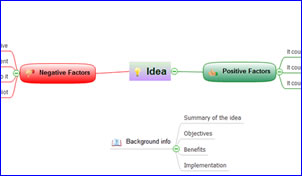 Most people, when faced with a new idea, find it easy to identify things that are wrong about it or reasons why it won’t work. Psychologists call this a negative bias, and it seems to be hard-wired into our human brains. A survival mechanism left over from our caveman days, perhaps?
Most people, when faced with a new idea, find it easy to identify things that are wrong about it or reasons why it won’t work. Psychologists call this a negative bias, and it seems to be hard-wired into our human brains. A survival mechanism left over from our caveman days, perhaps?
The problem with negative bias in the modern world is that it causes us to kill new ideas far too quickly. To balance this tendency, we need to get in the habit of asking ourselves questions with a positive bias, like these:
- What is good about this idea?
- What is amazing about this idea?
- What is potentially beneficial about this idea?
This is much harder than criticizing a new idea, but it is time well spent, because it often helps us to identify things that are truly remarkable about the new idea – and can mentally predispose us to give it the attention and consideration it deserves.
As I was thinking about this process, it occurred to me that a mind map is an ideal way to evaluate our ideas in a fair and balanced way. Positive and negative factors can be placed opposite of each other and the central topic, helping us to visualize the positive and negative forces acting upon the idea. Here’s how to create such a map (click on the image above to view a larger version):
- For the central topic of the map, describe the idea in a few words.
- Create a new subtopic and name it “negative factors.” If necessary, drag it to the left side of the main topic.
- With this topic still selected, begin to create subtopics that briefly describe each of the reasons why this new idea potentially won’t work. Invest at least five minutes describing these factors.
- Select the central topic of your map and create a second subtopic entitled “positive factors.” If necessary, drag it to the right side of the central topic. Your map should now resemble a “tug-of-war” between positive and negative factors.
- Spend at least 5 to 10 minutes brainstorming why this new idea could potentially work, using the questions outlined above. One way to identify these positive factors is to take a negative factor and reverse it. Another useful way is to think about a negative factor and to ask yourself, “What would the effect be if this constraining factor was eliminated or didn’t exist?” What we’re trying to do here is to envision how your idea would perform if this negative factor was minimized or completely eliminated.
- If you find that this whole process is a little bit too abstract for you, you may want to consider creating a floating topic in which you deconstruct the idea in as much detail as possible. Use as many levels of topics and subtopics as needed in order to fully describe the idea. For best results, I recommend that you position this branch directly above or directly below the central topic, so it does not interfere with the “tug-of-war” between the positive and negative factors. You can then use the content of this part of your map as inspiration for brainstorming the positive and negative factors.
One other potential embellishment: Color the positive factors topic and all of its subtopics green, to emphasize their positive focus, and recolor the text and lines for the negative factors to red, to emphasize their negative nature. If you choose to add a branch for background information about the idea, this can remain black to emphasize that it represents supporting information.
The next time you need to think about a new idea in a balanced way, why not give this technique a try?

Leave a Reply